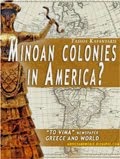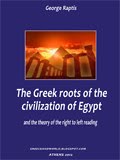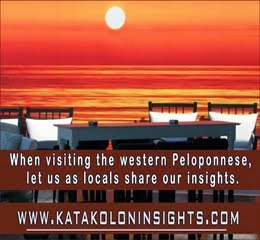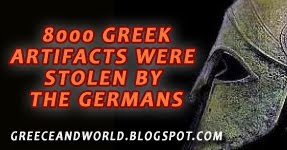Sounds unbelievable, but may be true. Numerous findings seem to concede that the Minoans were keen navigators who crossed the Atlantic. They created colonies even in Canada and exploited local copper mines. All this before Columbus!
Tassos Kafantaris
a.Kafantaris@gmail.com
It has not been many years since I heard the Professor of the University of Patras Anthony Kantaratos, talking specifically - about the possibility of ancient Greeks had arrived in …America, searching for new sources of metals.
I admit that I smiled then, thinking about all the other unlikely I had read about the ancient Greeks in America, Australia or Japan. And I would keep this story in my subconscious, if not learned about a recent book – The Lost Empire of Atlantis of Gavin Menzies- which returned resoundingly the issue and raised a host of discussion on the internet. Gavin Menzies, in his book, initially follows the Minoan traces in Asia Minor, in Egypt, in Yemen, in India and Ceylon- where the Sangam epics of the Tamil still speak about “the magnificent ships of the Greeks bringing gold and leave laden with pepper…”. Surprised by the museum findings which vindicated Strabo and Ptolemy, the author not only considered the navigation secrets held by the Minoans, but also where they found all those quantities of metals that they traded. The copper mines of Cyprus as it is historically known could not even meet the requirements of the Pharaohs. Yet the Minoans gave them bronze saws doped with tin to cut the stone blocks of the …pyramids. As was written in the records of the Acadian king Skarga, the Minoan ships brought since 2350 BC tin from Spain and Britain. And then this unlikely finding of 1450 BC at the Akrotirion in Santorini where did it come from? Lasioderma serricorne, meaning larva of the tobacco leaf! Yes the smoke that we all knew that first arrived in Europe in 16th century AD from the American continent. So, Menzies, now turned west searching to find whether-and how-those intrepid sailors had not only crossed the portals of Hercules, but had also arrived in the New World.
Minoans and Mycenaeans on the Atlantic coast
The roadmap that was unfolded in the rest of the book by this 72 years old former officer of the British navy was not unprecedented: Two years ago, at the TV channel NET (watch video: http://www.youtube.com/watch?v=NtfCGg-o04A), and in the newspaper NEA (www.tanea.gr/politismos/article/?aid=4557236) , geology professor and member of the Central Archaeological Council Margiolakos Elias , had supported the idea that our ancestors had explored the coastal areas of Spain, France, Britain and Ireland in search of minerals and perhaps had arrived in Iceland, Greenland and America.
Specifically, the rationale of Mr. Mariolakos was given in a writing of him that you can find published on the Internet. There initially informs us how a geologist deals with one such issue: "The geomythology is a branch of earth science that deals with physical and geological conditions prevailing during the mythological era and, through this analysis, finds the connection between geology and mythology. My own experience as a geologist who has spent his life studying the geology of Greece, showed that (...) in Greek mythology are included physical and geological processes that evolve in very remote areas, such as in the North Atlantic and elsewhere '. And then analyzes in detail the ancient sources examined, such as the work of Plutarch "On the face shown attached to cycles of the moon."
The “suspect” mines
Skeptical as I was in my quest to give "evidence". From what he told me I concluded that there were two keys to unlock the case of "Greeks in America." One was a metallurgical inexplicable: U.S. archaeologists have found 5,000 open copper mines (almost entirely pure) on the shores of Lake Superior, Michigan between the U.S. and Canada, where there have been exported some 500,000 tonnes between 2470 to 1050 BC ., which ... nobody knows where they went! Specifically, the Indians in these regions then were living in the Stone Age, and only after 1500 BC began to use limited amounts of copper - and those only for jewelry. So who was the "thief" and from where and how did they come? Since the Mediterranean and Mesopotamia were those then passing through the Bronze Age (and copper was then more expensive than gold), the suspicions directed thither. By striking coincidence indeed, the mysterious massive copper mining both in North America and in Spain and Britain stopped around 1350 BC - The time the volcano of Thera (Santorini) determined the fate of the Minoans. And the Greeks who received the baton (Mycenaeans Achaeans initially, Dorians and Ionians then) are the ones who tell long trips in Ogygia (Iceland), the Sea of Kronos (North Atlantic) and the westernmost coast. On how they went, the answer could only be given to the key called knowledge of ocean currents - currents of the ocean that Homer described as βαθύρροο, meaning flows deeply and βαθυδίνη, twist in the deep. The current of the Gulf of Mexico, the famous Gulf Stream, twists the Atlantic branching in loops that penetrate the Mediterranean and the Baltic. Anyone who knows these places and Waterslides and place properly his hull onto them can "flies". For example - says Mariolakos - Plutarch concluded that a boat like the "Argo" could have traveled the 900 km distance between Britain and Iceland in 5 days (4-5 miles / hour).
Minoan sea cruises in the sea of Kronos (North Atlantic)
Minoan words and sketches of ships await their explanation on the rocks of the coast of the Baltic.
The arguments of Professor Mariolakos were impressive and seemed reasonable. The achievement extraordinary but he could not be satisfied only with the evidence that ancient ships like the "Argo" could go so far - let alone the even more ancient Minoan ships. I remembered a story of 2010 by a Norwegian newspaper, according to which mysterious letters of the period from 1800 to 1000 BC had been carved in granite. These letters deciphered as Minoan by the Norwegian linguist and scholar Kjell Aartun who was honored about it with the gold medal of the king. In Aartun, the Minoan words translated "Soft and pure", referring to the largest deposit of silver across Europe which were found by these incredible treasure hunters in the Kongsberg region of Oslo. But had they left other traces behind them?
I asked Dr. Mina Tsikritsi who previously had identified the "earthen computer navigation" of the Minoans about it. When contacting us he questioned the interpretation of Aartun, but was certain that it was Minoans, as a recent study of him added evidence supporting the theory of Professor Mariolakos for passage to the other side of the ocean. He specifically said:
Plutarch on Canada
One of the beaches –veins- of copper in Lake Superior in the U.S., with traces of ancient mining
- "Plutarch writes:" As to the great continent, from which the great sea is contained in a circle from the other islands is less in distance, but the Ogygia about five thousand stages traveling by boat with oars. (...) from the mainland Greeks residing nearby places around vagina no less than the Maiotida (lake), whose mouth is in line with the mouth of the Caspian Sea. "The distances between Greenland, Newfoundland and Baffin Island in Canada is about 1,140 km, and between Newfoundland and Baffin Island is about 1,300 km A report that around the bay there are Greeks reveals a Greek colony in the Gulf of St. Lawrence.
The important thing in this description is that it provides geographic information that are correct. Indeed, the Gulf of St. Lawrence resembles Maeotid lake (Sea of Azov, Black Sea) and is slightly larger. As for the information that the mouth of the bay is in line with the mouth of the Caspian, looking in Google Earth anyone can easily discern that the two ports are located at latitude 47th, so on the same line. This information is the only reference in ancient literature that shows us that they were able, at that time, to determine the latitude of a place. But there is something more in Plutarch that I consider proof that the theory of travel to America is true".
So What..
- "He says:" When the star of Saturn, which we call Bright (Φαίνοντα) while those nocturia, arrived in Taurus after a period of thirty years, after much time preparing for the sacrifice ... (start the return journey). "This enables us to control the astronomical period was possibly made this trip recounts. Plato had classified the planets in the solar system in order from outside to inside relative to the Earth, with the following names: Fainontas (Saturn) Faethontas (Jupiter) Pyroentas (Mars), Lucifer (Venus) , Stilvontas (Mercury), Sun and Moon. The name Fainontas etymologically means that which is visible, while the word nocturia means this is the last to be seen in the night.
Using special astronomy program I have checked the geographical coordinates of Canada in the time of Plutarch (1st century AD.) At what date and in what month the planet Saturn is in the constellation of Taurus before the sun rises. I have confirmed that every 30 lunar years appears indeed the phenomenon of Saturn rising in Taurus. Then, again, Plutarch says: "The islands are inhabited by Greeks over and watch the sun hide for less than an hour for thirty days. And the night there is a light darkness and dawn shines from the west." Since the return journey began early June, then we need to check where they faced the sun hiding under an hour for 30 days. With appropriate program found that at the time of the first century. B.C. Greenland (60 degrees north) the sun set for an hour between 04.05 am and this was for a period of one month, from 9/6 up to 9/7. This identification indicates that they initially traveled north, reaching close to the Arctic Circle, where the sea was called Cronion Sea (Sea of Cronus). In this area night has actually a dawn like darkness and light. This astronomical connection, combined with the geographical knowledge of the two sites that have the same latitude, shows that the journey described by Plutarch - from America to Carthage, 86 AD - actually happened.
The reasoning was shocking, but what held me was that we were measuring data of a longer trip of the Roman era - a time when perhaps the travelers had in use the Antikythera Mechanism onboard. What evidence do we have that Minoan ships achieved the journey? Surprises from the land of the Vikings gave us the answer.
Traces and intrigues in the New World
What remained was to find relevant evidence on the shores of St. Lawrence or Lake Superior to accept as likely the unlikely of the Minoans presence in America. Menzies mentioned such the “ 1.200 Minoan finds around Lake Superior “. So I set out to find them.
It was revealed that the findings are indeed a lot: the first non-Indian elements were found in mining copper veins, at the Keweenaw Peninsula of Lake Superior - near a village called ... Lavrion (Laurium). There was also found a petroglyph of a highly symbolic Minoan ship. Also in Newberry, Michigan, had already in 1896 been found three statues and a label with "strange writing ". Nobody could interpret it then, but when Evans went to the excavations of Knossos - in 1900 - it became apparent that the writing was also related to Linear A.
The abundance of 'imaging elements "referring to the Mediterranean was subsequently found in private hands, with most of them ending up to unknown collectors and many of them - gold and silver - is rumored to have been melted by the greedy predators. Most were found in 1925 by a farmer in Illinois, Orville Lowery, and in 1982 by an adventurer named Russ Burrows, who claimed to have found a sanctuary and 13 undisturbed tombs in a cave complex, also in Illinois.
To sum up briefly, the listed Internet findings on American soil include numerous stones with engraved- on them- forms of soldiers in uniforms reminiscent Minoans, Philistines, Mycenaeans, Phoenicians and Egyptians, many Petroglyphs with Minoan and Egyptian types of ships, and other inscriptions with Cypro-Minoan writing and other composited with Etruscan, Latin and Greek words. The most eloquent optically element (if proven authentic) is a medal that was found in Cleveland, Ohio in 2006, the Minoan axe on one side and on the other the Prince of Lilies that we know from the mural in the palace of Knossos (1690 BC)!
Self proclaimed Archaeologists – Messiahs
The issue got more complicated when the "Indiana Jones of the Bronze age" were approached by "archaeologists - militants" of the Mormon Church, who were attempting to vindicate the spoken by their prophets that, America was colonized by... Jews around 2000 BC. Since then an incredible carousel has been erected with nterpretations of any kind -of the findings- to “spring up” on the non scientific magazine Ancient American, while the official archeology is absent. This paradoxical situation has led to a weakness of the crossing of the truth of the allegations and to the expression of fiery theories. For example, a epigraphologist named Paul Schaffranke claimed in his 1995 lecture that he deciphered the composite writing of the ancient plates and that it tells an incredible Requiem of those first settlers of America: that Greeks of Alexandria – fugitives of the now Christian Roman Empire - the last refuges, strongheld to the Phoenician Mauritania, and from there came together in the Great Lakes, to build their gross and last kingdom!
Indians with Cretan DNA
The only scientific fact that we have to support all the scenarios of colonization of the Mediterranean is the genetic study: «Origin and Diffusion of mtDNA Haplogroup X», 2003 (vl.www.ncbi.nlm.nih.gov/pmc/articles/PMC1180497 /) . In this was detected that the mtDNA haplogroup X2 that is encountered in the Cretans in a high percentage (7.2%) occurs at a similarly high rate (to 5%) in 20,000 members of the Native American tribes of the Northeast America! In such a "Eurasian conclusion" was reached also the cranial comparative study of the University of Michigan «Old World sources of the first New World human inhabitants: a comparative craniofacial view», 2001. Then, in 2008, the work of a team of researchers from universities in Greece, USA, Canada, Russia and Turkey, under the professor of the Aristotle University, Constantine Triandafyllidis turned the projector of the genetic tracing back further: he concluded -by DNA- that Minoans had settled in Crete coming from Anatolia - the same place that in the 2nd millennium BC was conquered by the Hittites.
And then I remembered that Minos had married the witch princess of Colchis, Pasiphae. Was Colchis the sister kingdom of the expatriated Minoans? Scenario that fits well with the fact that Georgian epigraphologists insist that the language of the Phaistos Disk is in hieratic script of the ancient Colchis. And what was said in the "Argonauts" by Orpheus about the Argonauts escape to the Baltic through Borysthenes (Dnieper) and their course to the island of Medea’s sister, Circe, to the coast of Mauritania, delivers a new meaning for the extent of Minoan naval.
Should we rewrite the books?
But are all these enough to write again the history books, to forget that Columbus was from “Chios" and to engage that "the Last of the Mohicans was a Cretan patriot"? Not yet. Some mummies that were found in the "colonization" of America and in the neighborhood of Stonehenge in England perhaps illuminate better the case. But we will be sure if only archaeologists decide officially.
"Why", I asked Professor Mariolakos, "Since you are a member of the Central Archaeological Council (KAS), do not send an archaeological expedition on Lake Superior;”. "We should, as by now identified and sunken port projects have been found in the region," he replied. "From a scientific perspective, the Greek scientists can carry out the research project - and within one to two years we will have the answers. However, the APC is an Advisory Council, which does not form the research department policy and therefore can not take this decision. Besides the ministry, of course, there are the archaeological departments of the University. But in order to do such a thing, we must find both the necessary resources and will by our archaeologists ", added meaningful.
Source: “TO VIMA” newspaper Sunday April 8th 2012.
Related:
http://araenil.wordpress.com/2011/06/26/evidence-of-prehistoric-connections-crete-norway/
Prehistoric connections Crete / Norway . English version
http://araenil.wordpress.com/2011/06/26/evidence-of-prehistoric-connections-crete-norway/
Cherokees Spoke Greek and Came from East Mediterranean - See more at:
http://dnaconsultants.com/announcements/cherokees-spoke-greek-and-came-from-east-mediterranean#sthash.65D24aXH.dpuf

















































